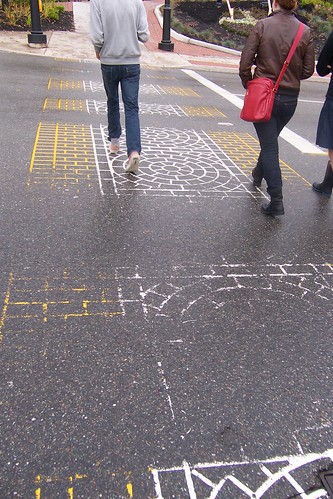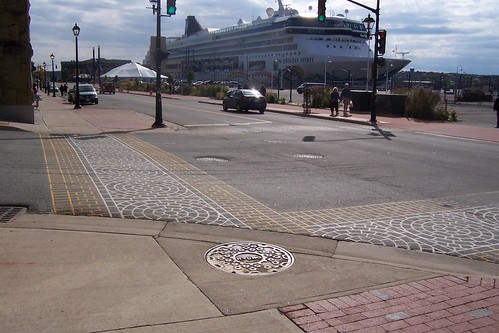
SAINT JOHN – Besides admiring the beautifully designed bus shelters, while visiting Saint John over thanksgiving weekend I spent a lot of time moving around the city by foot, and what caught my attention were some of their crosswalks. Rather than the standard solid block lines found in most cities (Halifax, Toronto, Montreal, etc.), some of Saint John’s crosswalks were stenciled brick patterns.
While these are pretty gimmicky-looking, and are clearly calling out for tourists–many were strategically placed near the landing docks and on the most historical streets; see photo below– they do raise the interesting question of what kind of public art we allow on the streets. Joshua Biggley dug into the politics of art in public spaces in his last post on Charlottetown, showing how municipally approved art often cause controversy because it ostensibly symbolizes the approval of the greater public. Yet what about the kind of art that we passively accept on our streets, and is allowed precisely because it doesn’t challenge anything or push any boundaries?
It’s a problem to think that all public art should have to conform to the tastes of the general public. Public art shouldn’t be about avoiding conflict, but should instead be about injecting individuality and difference onto common spaces, creating unexpected experiences that can potentially unsettle those who have grown accustomed or become dulled to a certain urban space. Sometimes we call these art forms vandalism; other times, the work of City Hall–approved artists. In my mind, stenciling gets at the heart of this tension, making Saint John’s crosswalks particularly thought provoking.
Take Banksy’s work all over the world. Once an arrested street vandal whose works were painted over only days after they would go up; now a world phenomenon whose murals are municipally protected landmarks and whose prints go for hundreds of thousands of pounds at Sotheby’s in London.
Or for a more local example, a different kind of stenciled crosswalk was done in Montreal by Roadsworth, an artist who went out in the middle of the night to do his work, only to have it removed soon after. Although shaped like a footprint, his crosswalk was still clearly a crosswalk, just like the spray-painted brick in Saint John. Yet I’m betting those bricks weren’t sprayed on during the middle of the night, or that the guy doing it wasn’t constantly glancing over his shoulder for cops. There’s a neat video documenting Roadsworth’s troubles with the law and the particularly interesting nature of the politics behind public art. Definitely sheds some light on how an otherwise unexciting piece of urban design can actually be a politically symbolic act.

photos by Jake Schabas

5 comments
An interesting footnote: Roadsworth was commissioned last summer to do stencils on Ste. Catherine St. in downtown Montreal.
https://spacing.ca/montreal/2008/07/07/roadsworths-downtown-street-stencils/
The Cultural Affairs Officer for the City of Saint John has long mulled holding a design competition for local artists to create a series of crosswalk “murals” throughout the Uptown area. Crosswalks could be even more exciting if he ever decides to turn that idea into action.
There are some stylized crosswalks in downtown Dartmouth, with a similar brick pattern.
These are good as public art if done uniquely, and can clearly demarcate crosswalks. One caveat is that, if regular road line paint is used, they can make for slippery corning for bicycles, scooters and motorcycles, especially when wet.
This company- http://www.integratedpaving.com/index.cfm – makes a product called street print which is a pressed asphalt product. It’s been widely used in NYC in crosswalk designs that intended to support neighborhood identity. It claims to be non-slippery, long lasting and un-affected by de-icers, plowing, etc.